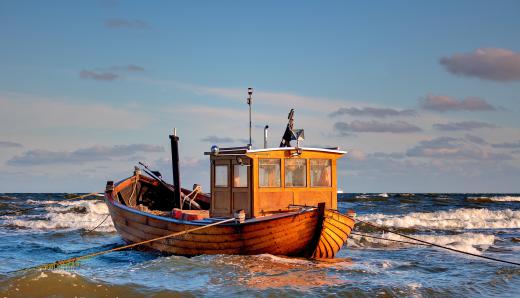There are many different types of fishing gear that are available. A basic fishing trip will require little more than a rod, reel and some bait, while a more advanced trip may include high-tech equipment, a power boat and much more. The equipment that is needed will hinge upon the skill level of the fisherman as well as his or her intended purpose, which can be sports fishing, casual fishing, and commercial fishing. No matter what the skill level of the fisherman is, one of the first things necessary is a fishing license, which will usually be required wherever the fishing is to be done.
For the basic, casual fishing trip where the fisherman intends to only catch a few fish, the necessary fishing gear begins with the rod and reel. A typical rod is around six feet (1.8 m) long and can made out of a variety of materials that are intended to be flexible and difficult to break. The reel consists of a spool of fishing line and a hand reel for bringing in the fish, and can be rather intricate for the professional fisherman. These essential tools are usually designed with a specific variety of fishing in mind, which can be spin casting, bait casting, spinning or fly-fishing.

A rod and reel is a good start, but will be useless without a hook and either live bait or a lure that will attract and capture the fish. These items are attached at the end of the line and vary greatly depending on the variety of fishing as well as the size and type of the fish to be caught. The most common type of live bait is the earthworm, but many other types exist such as minnows, crickets, grasshoppers and others. Lures are essentially artificial live bait, but do not necessarily need to look like creatures, and some are designed to attract fish purely through their sound and motion.

Another important piece of fishing gear to be used for storing equipment is the tackle box. These can be important because some of the equipment can be small and easily lost, so the typical tackle box is usually designed with many tiny compartments for lures, hooks, fishing line, pliers, a first aid kit and many more essential pieces of fishing gear. It is not usually wise for the fisherman to store live bait in the tackle box, however, because of its tendency to create a foul odor.

The places to fish are limitless, and other types of gear are made to accommodate the fishing locations, which can be in rivers, ponds, lakes, the ocean or on ice. Obviously one of the most important pieces of fishing gear on water is the boat, and there are many types that are designed specifically for fishing that must be bigger and have more power as the size of the body of water grows. The fisherman who is not using a boat may need waterproof clothing such as rubber pants, gloves and similar articles.

Finally, as in any sport, there are many high-tech gadgets designed for every level of fisherman. Electronic fish finders will scan in the water and show the fisherman how many fish are below, as well as how many weeds there are and the contour of the sea bottom. Practically every type of fishing gear has some kind of electronic counterpart, including electronic reels and even lures that use electronics to aid in their movement to attempt to attract bigger fish.
